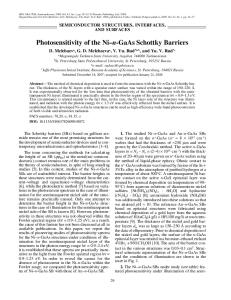Electron Transmission Through Modified Schottky Barriers
- PDF / 95,241 Bytes
- 6 Pages / 612 x 792 pts (letter) Page_size
- 44 Downloads / 338 Views
ELECTRON TRANSMISSION THROUGH MODIFIED SCHOTTKY BARRIERS Kevin L. Jensen Code 6840, ESTD, Naval Research Laboratory Washington, DC 20375-5347 USA
ABSTRACT The effects of a Coulomb-like potential in the Schottky barrier existing between a material-diamond interface is analyzed. The inclusion is intended to mimic the effects of an ionized trap within the barrier, and therefore to account for charge injection into the conduction band of diamond via a Poole-Frenkel transport mechanism. The present treatment is to provide a qualitative account of the increase in current density near the inclusion, which can be substantial. The model is first reduced to an analytically tractable one-dimensional tunneling problem addressable by an Airy Function approach in order to investigate the nature of the effect. A more comprehensive numerical approach is then applied. Finally, statistical arguments are used to estimate emission site densities using the results of the aforementioned analysis.
INTRODUCTION Injecting charge into the conduction band of diamond and other wide band gap materials is a prerequisite for exploiting their low or negative electron affinity characteristics as electron sources for rf amplifier devices. The lure of competitive emission current densities at low applied fields therefore motivates interest in such cold cathodes as a potential replacement for traditional thermionic electron sources. The modeling of electron transport through such films requires a knowledge of the incident electron energy distribution past the Schottky barrier which exists at the metal-semiconductor or semiconductor-semiconductor interface. Estimations of tunneling current and energy distributions are complicated by a host of modifications, such as interfacial layers, quadratic potentials associated with a depletion layer, neutral or charged defects, and the like. Recently, Göhl, et al. [1] argued that the I(V) characteristics of their measured emission from undoped CVD diamond could be explained by a “Poole-Frenkel” conduction mechanism [2], in which ionized trap centers (impurity atoms) give rise to overlapping Coulomb potentials and thereby provide conduction paths, a hypothesis also considered by Forbes in discussing low-voltage field induced emission through dielectric films [3]. The present study is an extension of an earlier work examining the effects of a charged inclusion in the oxide layer present on a single silicon field emitter structure [4]. The analysis proceeds on two levels. First, a simple and qualitative treatment of the impact of a square well in a Schottky barrier, which nominally models the Poole-Frenkel potential, is used to explore the nature of the current enhancement. Second, a “modified Airy Function” approach to modeling transport is used to analyze more realistic (but nevertheless one-dimensional) potentials [5] accounting for charged inclusions. In either case, it is seen that the presence of such an addition gives rise to a substantial increase in the local current density, depending on where the inclus
Data Loading...











